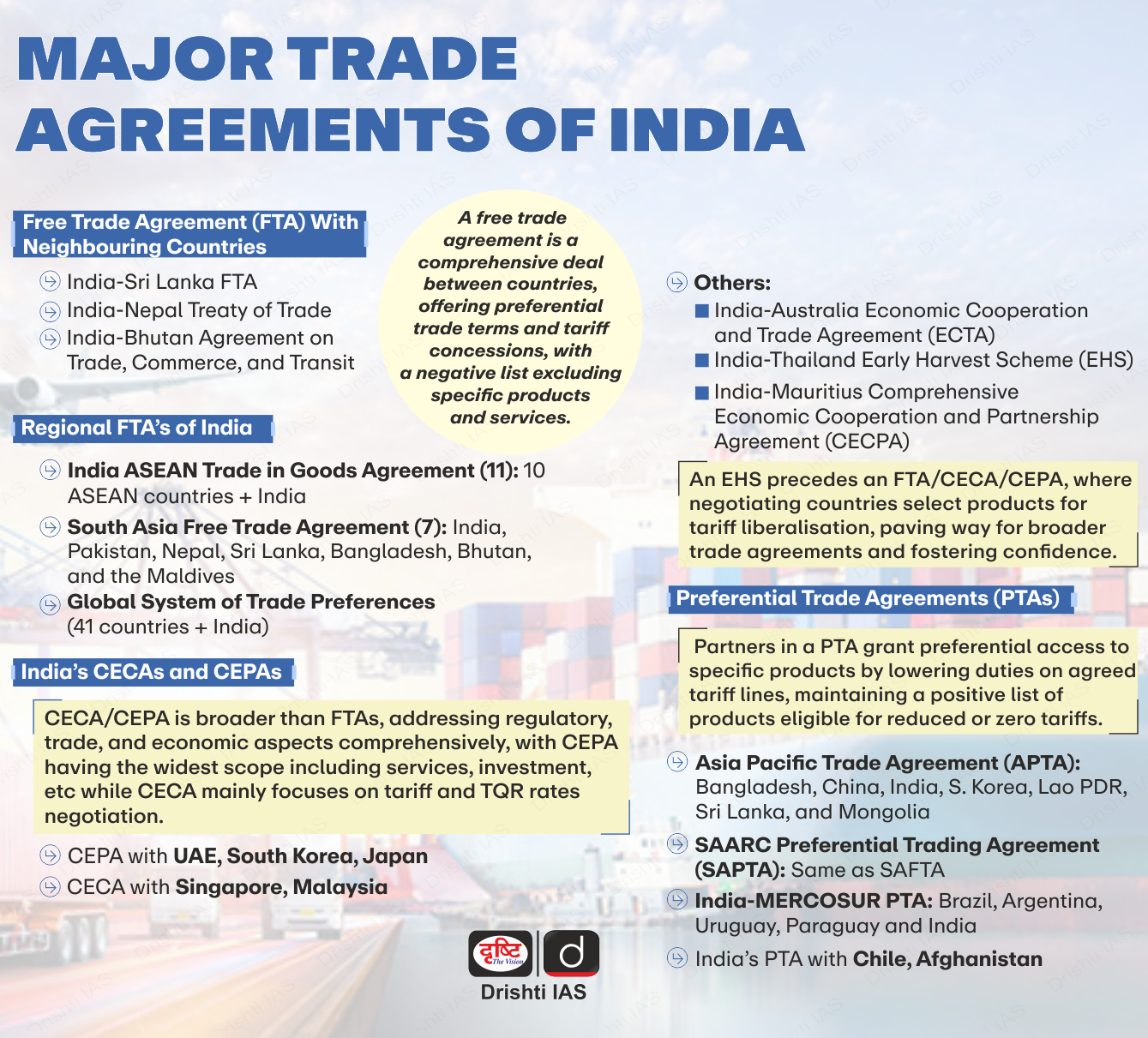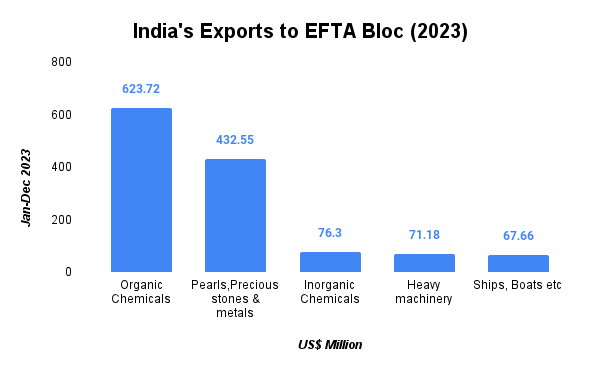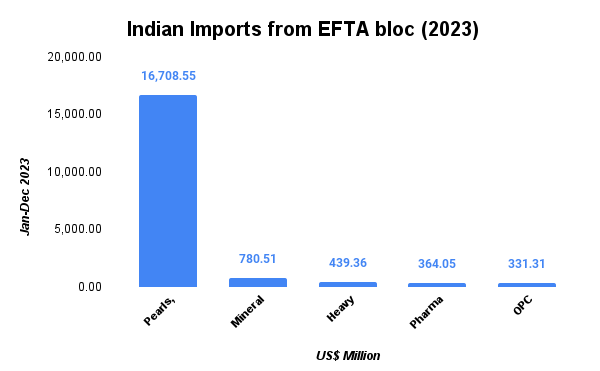International Relations
India-EFTA Deal: A New Chapter in Trade Agreements
- 15 Mar 2024
- 15 min read
This editorial is based on “A fresh stance: On India and the European Free Trade Association deal” which was published in The Hindu on 14/03/2024. It talks about the significance and challenges of the recently signed Trade and Economic Partnership Agreement (TEPA) between India and the European Free Trade Association (EFTA).
For Prelims: European Free Trade Association (EFTA), Trade and Economic Partnership Agreement (TEPA), Iceland, Liechtenstein, Switzerland, Norway, European Union (EU), Intellectual property rights, FDI
For Mains: Significance and Challenges in India-EFTA Deal
After 15 years of negotiations, India recently signed a Trade and Economic Partnership Agreement (TEPA) with the European Free Trade Association (EFTA). The EFTA today includes four non-EU countries — Iceland, Liechtenstein, Norway, and Switzerland.
The agreement stands as a potential game-changer for both parties, promising economic growth, job opportunities, and strengthening bilateral relations. However, it also presents challenges that must be addressed to move towards a more integrated and prosperous global economy.
What is the European Free Trade Association (EFTA)?
- About:
- It is an intergovernmental organization set up for the promotion of free trade and economic integration to the benefit of its four Member States – Iceland, Liechtenstein, Norway and Switzerland – and the benefit of their trading partners around the globe.
- History:
- It was established by a Convention signed in Stockholm on 4th January 1960.
- It aimed to serve as an alternative trade bloc for those European states that were unable or unwilling to join the then European Economic Community (EEC), the main predecessor of the European Union (EU).
- Main Tasks of the Association:
- Maintaining and developing the EFTA Convention, which regulates economic relations between the four EFTA States.
- Managing the Agreement on the European Economic Area (EEA Agreement), which brings together the Member States of the European Union and three of the EFTA States – Iceland, Liechtenstein and Norway – in a single market, also referred to as the “Internal Market”.
- Developing EFTA’s worldwide network of free trade agreements.
- India and EFTA:
- India’s exports to EFTA countries during 2022-23 stood at USD 1.92 billion, while imports were at USD 16.74 billion.
- The bilateral trade between India and EFTA stood at USD 18.65 billion in 2022-23.
- Switzerland is the largest trading partner of India followed by Norway.
- In fact, India has a trade deficit with Switzerland, largely due to gold imports.
- India-European Free Trade Association signed a Trade and Economic Partnership Agreement (TEPA) in March 2024.
What is the Trade and Economic Partnership Agreement (TEPA)?
- Objectives:
- The TEPA aims to create opportunities for trade and investment between India and EFTA by eliminating/reducing tariffs and non-tariff barriers on a wide range of products.
- It aims to ensure fair and transparent market access conditions for service providers and investors and will enhance cooperation on intellectual property rights protection and enforcement.
- TEPA aims to facilitate trade procedures and customs cooperation along with effective mechanisms for dispute resolution.
- Coverage:
- The agreement has 14 chapters, including trade in goods, rules of origin, intellectual property rights (IPRs), trade in services, investment promotion and cooperation, government procurement, technical barriers to trade and trade facilitation.
- Key Highlights of the Agreement:
- EFTA has committed to promoting investments to increase the stock of foreign direct investments by USD 100 billion in India in the next 15 years, and to facilitate the generation of 1 million direct employment in India, through such investments.
- For the first ever time in the history of FTAs, a legal commitment is being made to promoting target-oriented investment and the creation of jobs.
- EFTA is offering 92.2% of its tariff lines which covers 99.6% of India’s exports.
- India is offering 82.7% of its tariff lines which covers 95.3% of EFTA exports of which more than 80% of import is Gold. The effective duty on Gold remains untouched.
- The EFTA’s market access offer covers 100% of non-agri products and tariff concession on Processed Agricultural Products (PAP).
- India has offered 105 sub-sectors to the EFTA and secured commitments in 128 sub-sectors from Switzerland, 114 from Norway, 107 from Liechtenstein, and 110 from Iceland.
- TEPA has provisions for Mutual Recognition Agreements in professional services like nursing, chartered accountants, architects, etc.
Why Does the India-EFTA Deal Hold Significance?
Economic Growth and Job Creation:
- Investment Boost:
- The anticipated USD 100 billion in FDI from EFTA countries over 15 years is crucial for India's infrastructure development, technological advancement, and job creation.
- TEPA will give impetus to “Make in India” and Atmanirbhar Bharat by encouraging domestic manufacturing in sectors such as Infrastructure and Connectivity, Manufacturing, Machinery, Pharmaceuticals, Chemicals, Food Processing, Transport and Logistics, Banking and Financial Services and Insurance.
- Trade Expansion :
- TEPA would stimulate our services exports in sectors such as IT services, business services, personal, cultural, sporting and recreational services, other education services, audio-visual services etc.
- Market Access :
- Under the India-EFTA free-trade agreement, Indian customers will get access to high-quality Swiss products such as watches, chocolates, biscuits, and clocks at lower prices as India will phase out customs duties under the trade pact on these goods over 10 years.
Strategic and Technological Benefits:
- Geopolitical Significance:
- The deal strengthens India's economic ties with Europe, fostering a more multipolar global trade landscape. This reduces dependence on any single trading partner and provides strategic benefits for India.
- Knowledge Sharing and Innovation:
- The deal can foster knowledge sharing and joint research ventures, accelerating India's technological development.
- It facilitates technology collaboration and access to world-leading technologies in precision engineering, health sciences, renewable energy, Innovation and R&D.
Setting a Precedent:
- Template for Future Deals:
- The successful implementation of the India-EFTA TEPA can serve as a template for future trade agreements with other European nations like the UK and potentially even the EU.
- TEPA provides an opportunity to integrate into EU markets. Over 40% of Switzerland’s global services exports are to the EU. Indian companies can look to Switzerland as a base for extending its market reach to EU.
- Free Trade Champion:
- India's successful negotiation and signing of the TEPA reinforces its image as a champion of free trade. This can attract further foreign investment and position India as a key player in the global trade arena.
Long-Term Benefits Beyond Just Trade:
- Streamlined Processes:
- The agreement goes beyond just tariffs, addressing areas like intellectual property rights, services trade, and government procurement. This comprehensive approach fosters a stronger economic partnership with long-term benefits.
- Commitments related to Intellectual Property Rights in TEPA are at the TRIPS level.
- Sustainable Development:
- The TEPA incorporates provisions for promoting sustainable development practices in trade and investment. This ensures environmentally conscious growth and aligns with global sustainability goals.
What are the Key Issues in the India- EFTA Agreement?
- Exclusion From FTA:
- India has excluded sensitive sectors like agriculture and dairy from significant tariff reductions. Sectors such as dairy, soya, coal and sensitive agricultural products are kept on the exclusion list and there will not be any duty concessions on these goods.
- FTA’s biggest export to India by far is gold, mostly from Switzerland. The effective duty on Gold remains untouched.
- This might limit the benefits for some EFTA exporters.
- The USD 100-Million Legal Commitment:
- If the USD 100-million commitment is not fulfilled, then there is a provision in the agreement that if the proposed investments do not come because of some reasons, India can “re-balance or suspend” the duty concessions to the four countries.
- Data Exclusivity:
- One of the key concerns is the proposal to introduce an additional IP barrier—data exclusivity (DE)—which could potentially delay the manufacturing of generic versions of new medicines, biologics, and preventive HIV therapy for a defined period, even when there is no patent on the medicine.
- The proposed data exclusivity provisions, insisted upon by EFTA nations, would prevent domestic generic drug manufacturers from utilizing data from preclinical tests and clinical trials conducted by the original patent holders.
- The Difference in Income Level:
- There is a huge difference in per capita incomes between India (USD 2,500) and the EFTA countries (USD 60,000-70,000).
- So an FTA must consider ways and means to provide equal opportunity for the latter to catch up.
- Non-Tariff Barriers (NTBs):
- Streamlining non-tariff barriers like differing product standards and technical regulations is crucial. Inconsistencies can create hurdles for businesses trying to export goods, as they may need to modify products to comply with regulations in each market.
- Domestic Resistance:
- Some Indian sectors, particularly those facing competition from EFTA imports, might express concerns about job losses or unfair competition.
What Should be The Way Forward to Ensure the Success of The India-EFTA Deal?
- Addressing Asymmetries by Finding Common Ground :
- Investment Protection: The deal should include provisions for the protection of investments, ensuring a conducive environment for businesses to invest and operate in each other's markets.
- Phased Reductions: For sensitive sectors like agriculture, India could consider phased tariff reductions, allowing domestic producers time to adjust and become more competitive.
- Compensation Packages: Tailored compensation packages for affected industries can ease concerns and provide support for necessary restructuring.
- Dispute Resolution Mechanism: Establishing an effective dispute resolution mechanism is crucial to address any trade-related disputes that may arise and prevent escalation into trade conflicts.
- Bridging the Regulatory Gap Through Streamlining for Efficiency :
- Reduce Non-Tariff Barriers: Efforts should be made to reduce non-tariff barriers such as technical regulations, standards, and customs procedures that can hinder trade flows
- Mutual Recognition Agreements (MRAs): Establishing MRAs for specific product categories can ensure products that meet one country's standards are automatically accepted by the other.
- Joint Technical Committees: Forming joint committees dedicated to harmonizing technical regulations can expedite the process and promote consistency.
- Building Capacity By Providing Tools for Growth:
- Training and Skill Development: Investing in training programs for customs officials and businesses on the new trade regime will ensure smooth implementation.
- Infrastructure Upgrade: Upgrading customs infrastructure and logistics networks can handle the anticipated increase in trade volume efficiently.
- Fostering Collaboration With A Shared Vision:
- Regular Stakeholder Dialogues: Maintaining regular dialogues between governments, businesses, and civil society can address concerns and ensure transparency.
- Knowledge Sharing Programs: Encouraging knowledge exchange in areas like best practices and technological advancements can benefit both regions.
Conclusion
The deal presents a unique opportunity to forge a stronger, more integrated partnership that benefits both sides and sets a positive precedent for future trade agreements. As India and EFTA countries embark on this exciting journey, the focus should remain on collaborative efforts, open communication, and a shared vision for a thriving economic partnership.
|
Drishti Mains Question : The India- EFTA (European Free Trade Association) Agreement stands as a potential game-changer for both parties, promising economic growth, job opportunities, and strengthening bilateral relations. Comment. |
UPSC Civil Services Examination, Previous Year Questions (PYQs)
Prelims
Q1. Consider the following countries: (2018)
- Australia
- Canada
- China
- India
- Japan
- USA
Which of the above are among the ‘free-trade partners’ of ASEAN?
(a) 1, 2, 4 and 5
(b) 3, 4, 5 and 6
(c) 1, 3, 4 and 5
(d) 2, 3, 4 and 6
Ans: C
Q2.‘Broad-based Trade and Investment Agreement (BTIA)’ is sometimes seen in the news in the context of negotiations held between India and (2017)
(a) European Union
(b) Gulf Cooperation Council
(c) Organization for Economic Cooperation and Development
(d) Shanghai Cooperation Organization
Ans: A
Mains
Q1. Quadrilateral Security Dialogue (Quad) is transforming itself into a trade bloc from a military alliance, in present times. Discuss.(2020)






.png)





